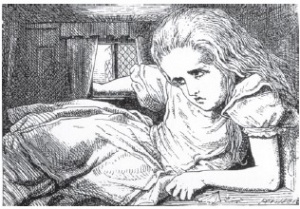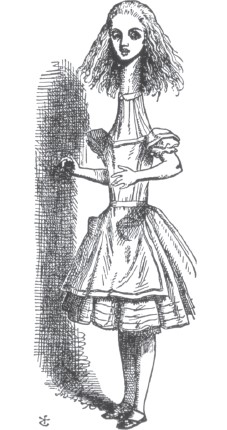Alice in Wonderland Syndrome
All content on Eyewiki is protected by copyright law and the Terms of Service. This content may not be reproduced, copied, or put into any artificial intelligence program, including large language and generative AI models, without permission from the Academy.
Disease Entity
Alice in wonderland syndrome (AIWS) is a disorder of visual perception. It was inculcated into medical literature by Lipmann in 1952, where he described it as an impairment of time, sense and body image[1]. Symptoms are similar to those perceived by the character in the book (Alice in wonderland) by Lewis Caroll.
Etiology[2]
AIWS is a rare neuro-ophthalmological entity with varied causes. No large epidemiological data has been published yet. The possible and common causes are listed below. Migraine is the most common cause followed by Infections principally by Epstein Barr virus.
- Migraine
- Epilepsy
- Hypnotic states
- Drug intoxication (e.g. lysergic acid diethylamide (LSD), marijuana)
- Fever
- Cerebral lesions
- Schizophrenia
- Infectious mononucleosis
- Encephalopathy by coxsackievirus , H1N1 influenza, borrelia burgdorferi, scarlet fever, typhoid fever,
- Toxic encephalopathy
| Type | Disease |
|---|---|
| Central nervous system pathologies | migraine, temporal lobe epilepsy, trauma associated encephalopathy, tumor, aneurysm, acute disseminated encephalomyelitis |
| Psychiatric disorders | schizophrenia, depressive syndrome, derealization/depersonalization disorder |
| Infectious diseases | Lyme disease, shigellosis, Epstein Barr virus, coxsackievirus, H1N1 influenza virus, cytomegalovirus and varicella zoster virus |
| Medications | montelukast, dextromethorphan, topiramate, risperidone |
| Psychoactive substances | Marijuana, LSD, cocaine ,amantia muscarim |
Pathophysiology
The temporo-parieto-occipital (TPO) junction is where the visual and somatosensory information is integrated to generate the inner and external representation of self. Other complex perception can be perceived by the patient if other areas of the brain are involved, evolving into complex somatosensory disorder.[3] AIWS has been attributed to the migrainous cortical dysfunction of the non-dominant parietal lobe.[4]
Studies have shown that electrical stimulation of the parietal lobe leads to distortion in the size and length of the image perceived. Decreased perfusion to the non-dominant parietal lobe during an attack leads to perception of symptoms.[5]Usually symptoms of AIWS can precede or accompany a migraine attack.
Diagnosis
Symptoms
- Metamorphopsia - visual distortions
- Macropsia - seeing images larger than normal
- Micropsia – seeing images smaller than normal
- Achromatopsia – inability to perceive color
- Teleopsia – seeing farther than normal
- Pelopsia – seeing closer than normal
- Visual hallucinations
- Partial/total body macro/micro-matognosia
- Quick-motion phenomenon
- Dysmorphopsia – lines and contours appearing wavy
- Feeling of derealization, depersonalization, somatopsychic duality
- Alteration in judgement of time
Micropsia and Telopsia are the most common symptoms.
Proposed classification of symptoms in AIWS[3]
| Types | Obligatory symptoms | Facultative symptoms |
|---|---|---|
| A | Aschematia:partial or total macrosomatognosia or microsomatognosia; paraschematia | Derealization, depersonalization, somatopsychic
duality, aberration in judgement of time |
| B | Macro- and micropsia and/or tele- and pelopsia. When micropsia and telopsia appear at the same time and for the same object:porropsia Lilliputianism (people appearing smaller) |
|
| C | Type A + type B symptoms |
Clinical Diagnosis
Diagnostic criteria for migraine associated with AIWS are:[6]
- One or more episodes of self-experienced body schema illusion or metamorphopsia
- Duration < 30 min
- Accompanied by headache or a history of migraine
- Magnetic resonance imaging (MRI), cerebrospinal fluid analysis, and electroencephalogram (EEG) all normal. However, visual evoked potentials (VEP) may be abnormal
Lanska and Lanska proposed that AIWS can be divided into pure Alice in wonderland (inter-personal) and AIWS (extra-personal), with the latter being more common.[7]
Diagnostic procedures
MRI and EEG maybe needed to exclude a structural cause but as mentioned in the diagnostic criteria above are normal.[8]
Management
Treatment
AIWS is typically a self-limiting condition.[9] Treatment of the migraine can alleviate AIWS symptoms. Antipsychotics have also been tried.
Prognosis
AIWS has no age predilection, but is most commonly seen in children and adolescents. Prognosis usually depends upon the underlying mechanism and should be treated appropriately.
References
- ↑ Losada-Del Pozo R, Cantarín-Extremera V, García-Peñas JJ, et al. [Characteristics and evolution of patients with Alice in Wonderland syndrome]. Rev Neurol. 2011;53(11):641-648.
- ↑ Brodsky MC. Pediatric Neuro-Ophthalmology. 2nd ed. New York: Springer-Verlag; 2010. https://www.springer.com/gp/book/9780387690698. Accessed September 22, 2019.
- ↑ Jump up to: 3.0 3.1 Mastria G, Mancini V, Viganò A, Di Piero V. Alice in Wonderland Syndrome: A Clinical and Pathophysiological Review. BioMed Research International. doi:10.1155/2016/8243145
- ↑ Evans RW, Rolak LA. The Alice in Wonderland Syndrome. Headache. 2004;44(6):624-625. doi:10.1111/j.1526-4610.2004.446013.x
- ↑ Hiemer S, Schoettler A, Kluger G, et al (1998): Gibt es das Alice-im Wunderland-Syndrom. In: Kohlschuetter A (ed.) Bentele KHP (1922): Aktuelle Neuropaediatrie. Novartis Pharma Verlag, Nuernberg, pp. 425–42.
- ↑ Valença MM, de Oliveira DA, Martins HA de L. Alice in Wonderland Syndrome, Burning Mouth Syndrome, Cold Stimulus Headache, and HaNDL: Narrative Review. Headache. 2015;55(9):1233-1248. doi:10.1111/head.12688
- ↑ DJ LJ and L. Alice in Wonderland Syndrome: somesthetic vs visual perceptual disturbance. - PubMed - NCBI. https://www.ncbi.nlm.nih.gov/pubmed/23446681. Accessed September 22, 2019.
- ↑ Liu AM, Liu JG, Liu GW, Liu GT. “Alice in wonderland” syndrome: presenting and follow-up characteristics. Pediatr Neurol. 2014;51(3):317-320. doi:10.1016/j.pediatrneurol.2014.04.007
- ↑ Beh SC, Masrour S, Smith SV, Friedman DI. Clinical characteristics of Alice in Wonderland syndrome in a cohort with vestibular migraine. Neurology: Clinical Practice. 2018;8(5):389-396. doi:10.1212/CPJ.0000000000000518



